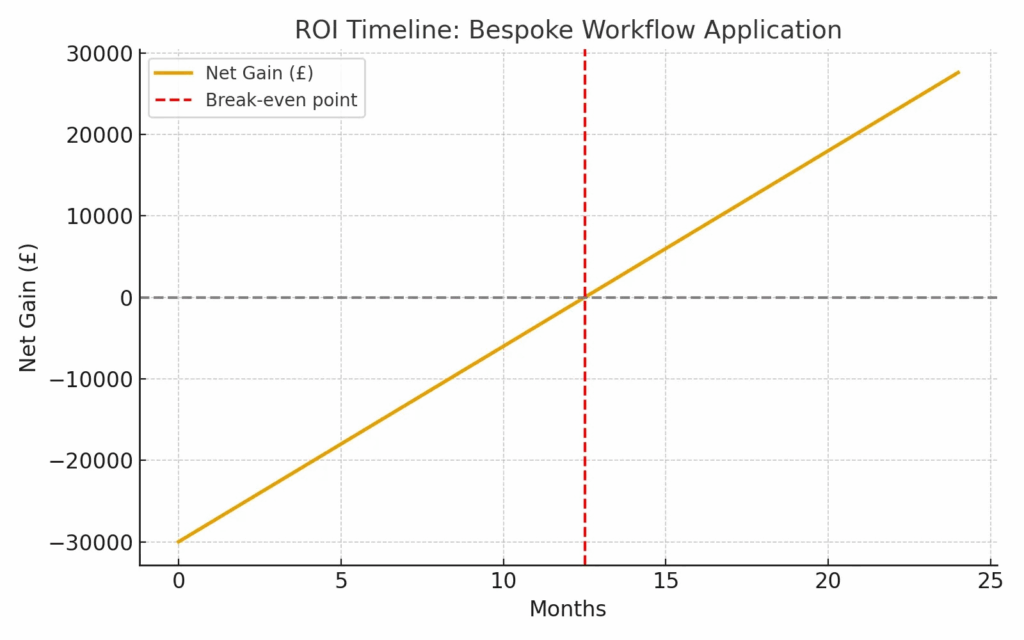Spreadsheets have been the lifeblood of small and medium-sized enterprises (SMEs) for decades. They are flexible, inexpensive, and familiar. From managing budgets to tracking customer data, spreadsheets have served as the default tool for countless businesses. But there comes a point when the very tool that once empowered growth begins to hold a business back.
This article examines why SMEs often outgrow spreadsheets, identifies the warning signs, and explains why bespoke workflow applications are increasingly the smarter investment.
The Comfort of Spreadsheets
It’s easy to see why spreadsheets are so popular:
- Low cost: Almost every business already has access through Microsoft Excel or Google Sheets.
- Flexibility: They can be adapted to almost any task.
- Familiarity: Staff are familiar with how to use them, so training requirements are minimal.
For a start-up or small team, spreadsheets can be the quickest way to get operational. But the very strengths of spreadsheets—flexibility and accessibility—become weaknesses when business complexity increases.
Warning Signs You’ve Outgrown Spreadsheets
1. Errors are becoming costly
Human error in spreadsheets is inevitable. A misplaced decimal or copied formula can cascade into significant financial or reputational damage. For SMEs, one mistake can mean the difference between profit and loss.
2. Data is duplicated across teams
When multiple spreadsheets are emailed around or stored in different folders, version control becomes a nightmare. Are you looking at the latest numbers? Which sheet is the “master copy”?
3. Scaling is painful
Adding more customers, products, or staff requires more tabs, formulas, and workarounds. Eventually, performance slows down and management becomes unmanageable.
4. Collaboration bottlenecks
Even with cloud spreadsheets, simultaneous editing can cause conflicts. Additionally, spreadsheets often lack proper access control, which can result in sensitive data being overexposed.
5. Compliance and audit pressures
As regulations like GDPR increase, SMEs need systems that provide audit trails, permissions, and security features. Spreadsheets simply weren’t designed with compliance in mind.
The Case for Bespoke Workflow Applications
1. Designed for Your Processes
Unlike off-the-shelf software, bespoke workflow applications are tailored to fit how your business operates. This means no more forcing your operations into generic templates.
2. Integration with Core Tools
Custom applications can seamlessly integrate with accounting platforms like Xero, collaboration tools such as Google Workspace and Microsoft 365, as well as logistics or CRM (Customer Relationship Management) systems. Data flows automatically—reducing duplication and errors.
3. Improved Efficiency
By automating repetitive tasks (such as quote generation, scheduling, or invoicing), businesses save time and reduce administrative overhead. Research consistently shows automation can deliver efficiency gains of 15–50% compared with manual processes.
4. Enhanced Security and Compliance
With role-based access, audit logs, and built-in GDPR compliance features, bespoke workflow apps help SMEs meet regulatory requirements without heavy manual oversight.
5. Scalability
As your business grows, the application grows with you. New features and integrations can be added without the risks associated with fragile spreadsheet structures.
Real-World Example
Take a property surveying company. Initially, spreadsheets were used to manage quotes, schedule surveys, and process invoices. As the business grew, errors increased, scheduling conflicts arose, and finance staff struggled to keep data synchronised with Xero. By moving to a bespoke workflow application:
- Quotes were automatically generated and tracked.
- Jobs synchronised directly with surveyors’ diaries.
- Invoices and commissions were handled seamlessly in Xero.
- Management gained real-time visibility of workload and revenue.
The result? The company reduced administration time by 40% and virtually eliminated missed appointments.
Another example is a logistics firm. Their reliance on spreadsheets meant tracking stock, handling multiple currencies, and managing different shipping providers all had to be done manually. By adopting a bespoke solution, they automated rate cards, gave customers access to real-time order tracking, and integrated directly with e-commerce platforms. The business could scale internationally without scaling staff costs at the same rate.
Balancing Costs and ROI (Return on Investment)
At first glance, spreadsheets feel “free” while bespoke software looks expensive. However, the hidden costs of spreadsheets, such as errors, inefficiency, wasted staff time, and lost opportunities, are substantial. Bespoke workflow applications pay for themselves through:
- Reduced manual work
- Improved customer satisfaction
- Fewer errors and rework
- Faster decision-making
For SMEs, this can translate into a return on investment within months, not years. And critically, it allows management to focus on strategic growth rather than firefighting daily inefficiencies.
Making the Shift
If your business is exhibiting warning signs, such as errors, duplication, scaling issues, or compliance headaches, it’s time to consider a workflow application. The transition doesn’t have to be disruptive. A phased approach, starting with the most painful bottlenecks, ensures a smooth move away from spreadsheets.
The most successful SMEs treat this as part of their digital transformation journey: moving from ad hoc, manual processes to resilient, integrated systems that position them for sustainable growth.
When Do You Get Your Money Back?
One of the most common concerns for SMEs is cost: how long will it take to see a return? In practice, bespoke applications often pay for themselves surprisingly quickly. If a business spends £6,000 a month on staff time for manual processes, and automation reduces that by 40%, the monthly saving is £2,400. A £30,000 development project is therefore recovered in just over a year, often faster when error reduction and improved customer retention are factored in. The point at which spreadsheets stop working is usually the same point at which the savings from a workflow application start to outpace the initial investment.

Final Reflection
Spreadsheets are like scaffolding: invaluable when you’re starting out, but dangerous if left in place when the building is meant to stand on its own. SMEs often cling to spreadsheets because they feel familiar and cheap, but in reality, they create invisible costs that erode margins, delay growth, and introduce unacceptable risk.
Bespoke workflow applications are not just about efficiency; they represent a mindset shift. They are committed to building a business that is scalable, resilient, and competitive in a digital-first economy. The businesses that make this shift early are the ones that thrive—not just survive—when markets tighten and customer expectations rise.

